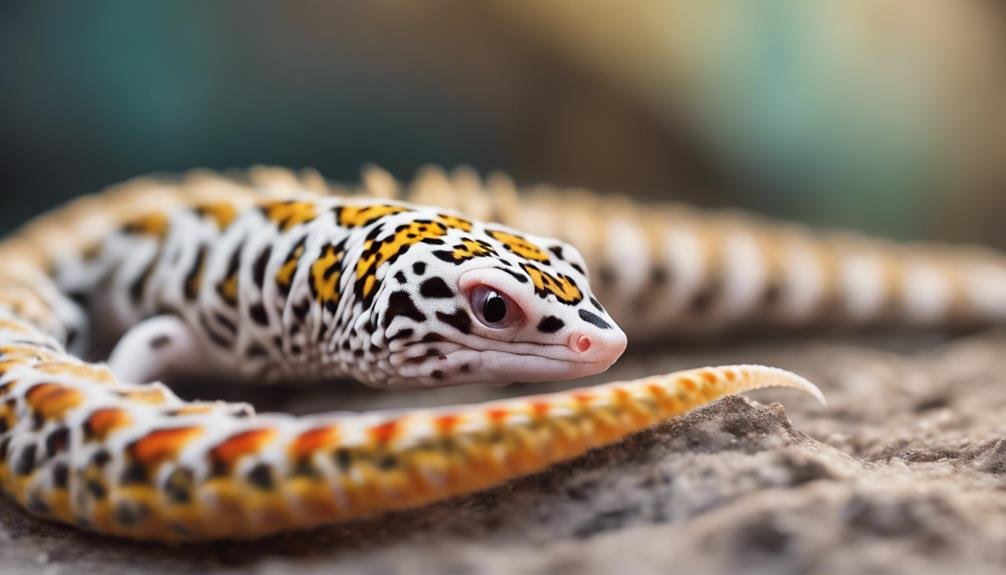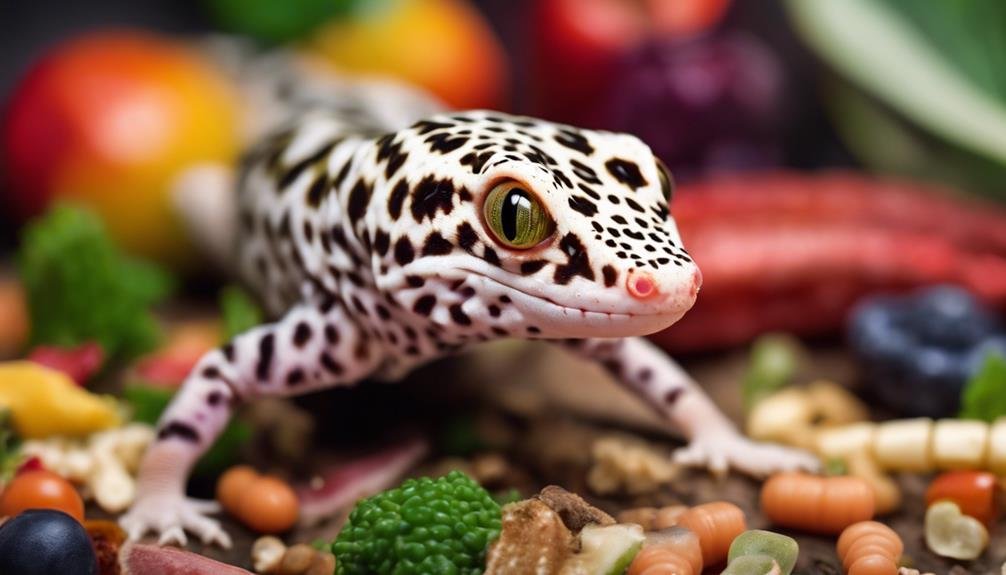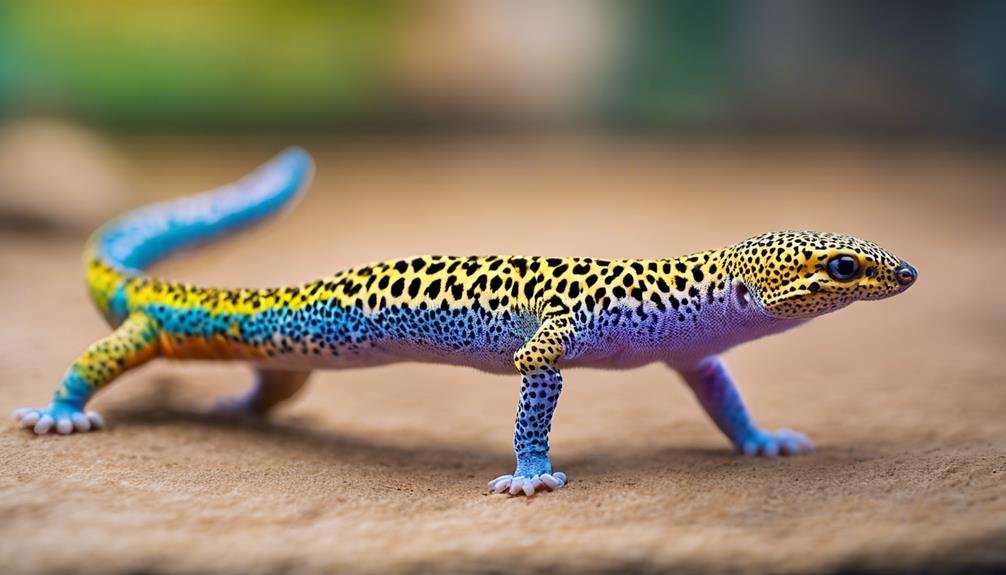If you're keen on ensuring your leopard gecko's tail regrows healthily, it's crucial to understand the nuances between healthy and unhealthy regrowth. A healthy regrowth should mirror the original in texture and color, indicating your care efforts are on point. However, spotting signs of infections or deformities early can prevent complications, making close monitoring a must. You might wonder how to differentiate between the two and what steps to take if things don't seem right. Stick around to uncover insights on nurturing ideal regrowth and what red flags to watch for, ensuring your gecko remains in top condition.
Key Takeaways
- Healthy tail regrowth in leopard geckos shows consistent growth and coloration matching the body.
- Signs of infection, such as redness, swelling, or discharge, indicate unhealthy regrowth and need veterinary attention.
- A diet rich in calcium, vitamins, and minerals supports healthy tail regrowth.
- Abnormalities in tail shape or texture suggest complications in the healing process.
- Restored balance and agility in the gecko's movements are indicators of successful tail regrowth.
Understanding Tail Loss
Understanding tail loss begins with recognizing it as a critical defense mechanism for leopard geckos, activated under stress or threat to safeguard themselves. When geckos feel threatened, whether due to fear, aggression from tankmates, or even mishandling, they can drop their tails as a distraction to escape potential danger. This dramatic response allows the gecko to flee, leaving behind a wriggling tail to confuse or occupy the predator. While this might seem alarming, it's noteworthy that geckos are capable of regrowing their tails, though the new tail may not look exactly the same as the original.
However, tail loss isn't without its risks. The tail serves as an important fat reserve for geckos, helping them survive during lean times. Losing this reserve makes them more vulnerable to illness and can impact their overall health if they're not cared for properly during the regrowth period. To prevent the tail from dropping unnecessarily, it's crucial to minimize stressors such as bullying from tankmates, improper handling, and environmental stress. Additionally, seeking prompt veterinary care for any tail injuries or infections is essential to guarantee a healthy regrowth process.
Initial Care Steps
After a leopard gecko loses its tail, the next important step is to focus on the initial care measures to guarantee a healthy regrowth process. The moments following gecko tail loss are pivotal; your first action should be to leave the gecko alone for 24 hours, giving you time to observe the tail injury without causing further stress. This period allows for a natural start to the healing process, and it's vital to prevent tail infection.
Ensuring the wound and the gecko's enclosure remain clean and dry is paramount. Swap out any substrate for paper towels, which should be changed daily to maintain a sterile environment. This simple step greatly reduces the risk of infection. Additionally, while your gecko may continue to have an appetite, it's important to remove any uneaten food promptly to avoid attracting bacteria or mold.
Applying a thin layer of polysporin to the wound every 2-3 days supports proper healing. This gentle intervention can help prevent tail-related complications and ward off signs of infection. By adhering to these initial care steps, you're setting the stage for a healthy and successful tail regrowth process.
Signs of Healthy Regrowth

Observing your leopard gecko's tail as it regrows, you'll notice several key indicators of healthy recovery, including consistent growth and coloration matching the rest of its body. When a gecko drops its tail, the process of tail regrowth is fascinating yet vital for its overall well-being. As the new tail emerges, you should see it gradually taking on the texture and appearance similar to the original tail. This similarity is a positive sign that the regrowth is proceeding as it should.
The coloration of the new tail should blend seamlessly with the gecko's body, indicating that the tail regrowth is healthy and the wound is healing properly. A properly regrown tail not only looks right but also restores balance and agility to your gecko, allowing it to move with its usual speed and precision. This is a clear sign that the gecko has successfully recovered from the trauma of losing its tail and is back to its agile self.
Keeping the wound clean during the initial stages after the tail drops is essential for this healthy regrowth. If you've followed the right steps, you'll see these signs of healthy tail regrowth, confirming that your care efforts have been successful.
Potential Complications
While you're watching your leopard gecko's tail regrow, it's important to be aware of potential complications that can arise. Infection risks and concerns about abnormal regrowth are significant issues that you'll need to monitor closely.
If you notice anything unusual, it's vital to seek veterinary advice to make sure your gecko's health isn't compromised.
Infection Risks
In the wake of tail loss, geckos face a significant risk of infection that can severely impact their recovery and tail regrowth process. When a gecko drops its tail, the site is vulnerable, and without proper care, infections can set in, threatening the delicate balance of health and recovery. It's important to understand the potential complications:
- Infections can derail the tail regrowth, turning a natural survival strategy into a health hazard.
- Symptoms of infection, such as redness, swelling, or discharge, require immediate attention to prevent further complications.
- Seeking veterinary advice isn't just recommended; it's a necessity to safeguard the well-being of your gecko during this sensitive time.
Abnormal Regrowth Concerns
You should be aware that abnormal tail regrowth in leopard geckos can cause deformities or functional impairments, posing significant health risks.
When a tail doesn't regenerate properly, it can lead to issues with balance and mobility, affecting your gecko's ability to move around its environment efficiently.
Additionally, abnormal regrowth might hinder your pet's communication skills, as tail gestures are an important part of their interaction with other geckos and their surroundings.
This improper regrowth can also impact your gecko's overall well-being, making it more susceptible to stress and other health issues.
If you notice any signs of abnormal regrowth, seeking veterinary intervention is essential. A vet can address these complications, ensuring your gecko maintains a healthy and active lifestyle.
Nutritional Support

Ensuring your leopard gecko's diet is rich in calcium, vitamins, and minerals is essential for healthy tail regrowth. When it comes to tail regrowth, a balanced diet plays an essential role in ensuring your pet's recovery is as smooth and efficient as possible. Feeder insects, such as crickets, mealworms, and dubia roaches, aren't just a source of entertainment for your gecko; they're packed with the protein necessary for healing and regrowth.
To maximize the benefits of these feeder insects, consider the following:
- Dust your feeder insects with calcium and multivitamin supplements to guarantee your gecko is getting all the essential nutrients needed for tail regeneration.
- Gut-load the feeder insects with nutritious foods before offering them to your gecko, enhancing the overall nutritional value of each bite during the critical tail regrowth phase.
- Monitor your gecko's appetite and adjust feeding frequencies to meet the increased nutritional demands during tail regrowth, ensuring your beloved pet has the energy and resources to heal effectively.
Preventing Future Loss
After addressing the nutritional needs for your leopard gecko's tail regrowth, it's essential to focus on preventing future loss.
You'll need to guarantee their habitat conditions are ideal, employ stress reduction techniques, and understand the essentials of diet and nutrition.
These steps will greatly reduce the chances of tail dropping and promote a healthier, stress-free environment for your gecko.
Optimal Habitat Conditions
Creating an ideal habitat for your leopard gecko is essential to preventing future tail loss. Consulting a reptile veterinarian can offer personalized advice on creating the best habitat conditions, which are important for minimizing stress-related tail dropping. Here are three key strategies:
- Maintain proper temperature and humidity levels in the enclosure to ensure your gecko's comfort and health.
- Provide adequate hiding spots and climbing structures to reduce stress and minimize the risk of tail incidents.
- Avoid overcrowding the enclosure to prevent bullying behavior among geckos, which can lead to tail loss.
Regularly inspecting the enclosure for hazards like sharp objects or tight spaces is crucial. Also, offering a balanced diet rich in essential nutrients supports overall health and reduces the likelihood of stress-related tail dropping.
Stress Reduction Techniques
To prevent future tail loss in leopard geckos, it's important to implement stress reduction techniques that focus on creating a secure and stable environment. When a gecko's tail fell, it's often a sign of stress.
Introducing environmental enrichment, such as hiding spots and climbing structures, can greatly lower their stress levels, making them feel more secure. Consistently maintaining the right temperature and humidity levels in their enclosure is also vital to stress reduction.
You should also aim to avoid sudden loud noises or disturbances to help create a calm environment for your gecko. Regularly observing your gecko's behavior for signs of stress and adjusting the environment accordingly can greatly help in preventing future tail loss.
Diet and Nutrition Essentials
While reducing stress is key to preventing tail loss in leopard geckos, guaranteeing they've a proper diet rich in calcium, vitamins, and minerals is equally crucial for healthy tail regrowth. Your gecko's diet directly impacts their ability to regenerate lost tails, with calcium playing a pivotal role in the process. Here's how you can support their diet:
- Incorporate gut-loaded insects like crickets and mealworms to ensure a nutritional balance essential for regrowth.
- Dust prey with calcium and vitamin supplements regularly to maintain peak health and support tail regeneration.
- Avoid fatty and sugary foods to prevent obesity, fostering a condition conducive to tail regrowth and overall well-being.
When to Seek Help
If your leopard gecko's tail stump shows signs of infection or isn't healing properly, it's important to seek veterinary help immediately. Abnormal healing can indicate a serious issue that might prevent your gecko from fully recovering.
When the regrown tail appears unhealthy or causes your pet distress, consulting a reptile specialist is the next best step. This guarantees that any potential complications are addressed early on, safeguarding your gecko's health and well-being.
Be on the lookout for unusual discoloration, swelling, or discharge from the tail area, as these symptoms may warrant professional evaluation. Persistent pain or discomfort, especially if your gecko has difficulty regrowing its tail, should prompt a visit to a vet without delay. It's crucial to remember that while tail regrowth is a natural process for leopard geckos, sometimes complications arise that require expert intervention.
Professional guidance becomes vital if the regrown tail poses any risks to your gecko's health or overall well-being. Ensuring your pet receives the best care possible means being vigilant and proactive about any signs of distress or abnormality during the regrowth process.
What are the signs of a healthy leopard gecko tail regrowth?
When a leopard gecko’s tail regrows, a healthy leopard gecko tail appearance is characterized by smooth and uniform scales, with no swelling or discoloration. The regrown tail should closely resemble the original tail in size and shape, indicating a successful and healthy regeneration process.
Frequently Asked Questions
What Does an Unhealthy Leopard Gecko Tail Look Like?
If you're wondering about an unhealthy leopard gecko tail, you'll notice a few key signs.
To begin with, tail discoloration is a clear red flag. Instead of its healthy color, it might look darker or unnaturally light.
You'll also see abnormal swelling, which isn't typical for a healthy tail.
Texture changes are a giveaway; it might feel harder or have an irregular surface.
If you spot these signs, it's time to seek a vet's advice.
How Do I Know if My Leopard Gecko Is Unhealthy?
To determine if your leopard gecko is unhealthy, watch for appetite changes, difficulties with skin shedding, and behavior shifts. If they're eating less, struggling to shed their skin, or acting differently, these could be red flags.
You should also look out for lethargy, weight fluctuations, and any physical signs like swelling or discharge. Regularly monitoring their eating and bathroom habits can provide clues.
If something seems off, it's best to consult a vet promptly.
Do Leopard Geckos Tails Grow Back if They Fall Off?
Yes, if your leopard gecko's tail falls off, it will grow back. This phenomenon, known as tail autotomy, is a natural defense mechanism.
The regrowth process depends on several factors, including the gecko's health and environmental conditions.
It's crucial to maintain a clean, stress-free habitat with proper nutrition to support healthy regrowth.
The new tail might look different, but it's a sign of your gecko's resilience.
What Should a Healthy Leopard Gecko Look Like?
When you're checking if your leopard gecko is healthy, you'll want to notice a few key things. Their skin should be smooth, without any lesions, and have vibrant coloration.
Their eyes must be clear, bright, and free from any discharge. Also, they should have a strong appetite, enthusiastically eating the food you offer.
If they're moving actively and their body looks well-proportioned, you're likely looking at a healthy gecko.
Conclusion
To summarize, if your leopard gecko's lost its tail, don't panic. Proper initial care and monitoring the regrowth process closely are vital. Watch for a tail that matches their body in texture and color, signaling healthy regrowth.
Be on the lookout for any signs of infection or abnormal healing. Proper nutrition and preventing future tail loss are essential. If something seems off, it's better to seek veterinary help early.
With the right care, your gecko's tail can fully recover, ensuring their happiness and health.

